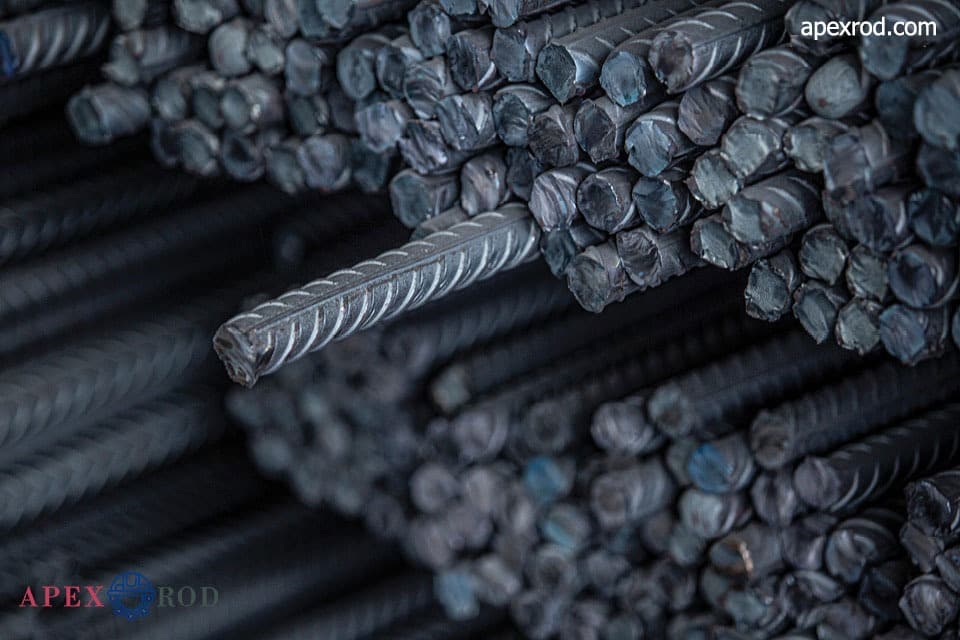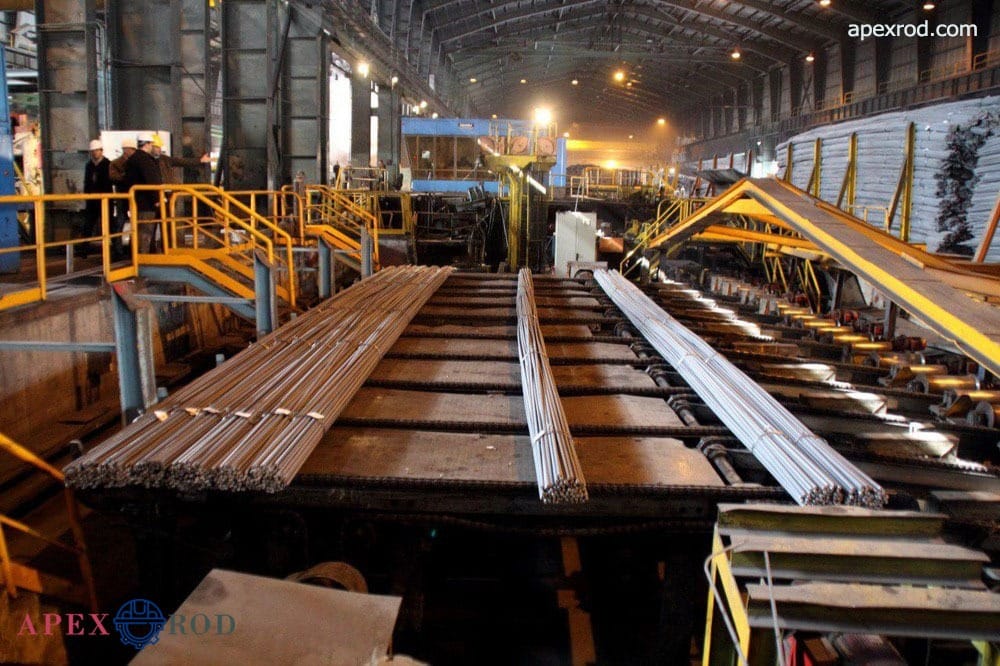Apexrod is a specialized supplier of steel rebar
We are the best in ouWe are Apexrod, a distinguished representative in the field of rebar exports. With years of experience and dedication in this domain, we proudly consider ourselves one of the largest rebar suppliers in Iran.r field of work
For Apexrod, quality is the utmost priority. Our products are crafted with precision, paying attention to the finest details. This commitment to quality sets us apart from other competitors and ensures that our customers receive the best possible product.
In addition to delivering excellent-quality rebar, we highly value developing long-term relationships with our customers. Trust and customer satisfaction are significant values for us, and we aim to establish stable and fruitful connections with our clients

List of Weight, Specifications, and Price of Steel Rebar
| - | PRODUCT | SIZE | SPECIFICATIONS | DELIVERY LOCATION | LENGTH OF ROD | WEIGHT OF ROD | PRICE PER TON (USD) |
|---|---|---|---|---|---|---|---|
| rebar | Φ 8mm | A3 | Factory in Iran | 12 meters | 5 kg | $515 | |
| rebar | Φ 10mm | A3 | Factory in Iran | 12 meters | 8 kg | $515 | |
| rebar | Φ 12mm | A3 | Factory in Iran | 12 meters | 11 kg | $515 | |
| rebar | Φ 14mm | A3 | Factory in Iran | 12 meters | 15 kg | $495 | |
| rebar | Φ 16mm | A3 | Factory in Iran | 12 meters | 19 kg | $495 | |
| rebar | Φ 18mm | A3 | Factory in Iran | 12 meters | 24 kg | $495 | |
| rebar | Φ 20mm | A3 | Factory in Iran | 12 meters | 30 kg | $495 | |
| rebar | Φ 22mm | A3 | Factory in Iran | 12 meters | 36 kg | $495 | |
| rebar | Φ 25mm | A3 | Factory in Iran | 12 meters | 46 kg | $495 | |
| rebar | Φ 28mm | A3 | Factory in Iran | 12 meters | 58 kg | $495 | |
| rebar | Φ 32mm | A3 | Factory in Iran | 12 meters | 76 kg | $495 |

what is rebar?
Rebar, short for reinforcing bar, is a fundamental construction material used primarily to support concrete. These steel bars, because of their unique mechanical properties, play a vital role in modern construction.
Application of Rebar
Rebar is mainly used to enhance the tensile strength of concrete, which naturally exhibits high compressive strength but low tensile strength. The integration of rebar with concrete creates a composite material that is resistant to both tension and compression forces.
Types of Rebar
Rebars are produced in various types based on material, surface pattern, and mechanical properties. Common types include
steel rebar,
stainless steel rebar (for corrosion resistance), and
composite rebars (such as Fiber-Reinforced Polymer, or FRP).
Based on the surface texture, rebars are classified into smooth and deformed (ribbed or twisted) categories, which affect their bonding with concrete.
Standards and Specifications
Rebars are manufactured according to specific standards that outline their physical, chemical, and mechanical characteristics. These standards ensure that the rebar possesses qualities suitable for various construction conditions and requirements.
Special Applications
Beyond building construction, rebars are used in a range of engineering projects, including bridges, tunnels, dams, and marine structures. The diversity in types and specifications of rebar allows for the implementation of varied and complex engineering designs.
In summary, rebar is an essential component in concrete structures, significantly contributing to the strength and durability of the construction. The choice of rebar type and specifications plays a critical role in the overall performance and longevity of a structure.
steel rebar price forecast
In the dynamic world of construction, the price of steel rebar is a crucial factor that significantly influences project budgets and planning. While precise forecasting of steel rebar prices is a complex task, fraught with uncertainties due to fluctuating global market trends, raw material costs, and geopolitical events, ApexRod offers a practical solution.
At ApexRod, we understand that the ability to predict future prices with absolute certainty is challenging. The construction industry is constantly evolving, and so are the factors that impact the cost of essential materials like steel rebar. That’s why, instead of focusing on uncertain forecasts, we concentrate on providing our clients with the most current and relevant pricing information.
Real-Time Pricing for Effective Planning
Our approach is straightforward yet highly effective. We ensure that the latest steel rebar prices are always available on our website, offering a valuable resource for contractors, builders, and developers. This real-time pricing information allows our clients to make informed purchasing decisions, manage budgets more effectively, and plan their projects with greater confidence.
We believe that transparency and up-to-date information are essential to successful project management in the construction sector. By regularly updating the steel rebar prices on our website, ApexRod empowers its clients with the knowledge they need to navigate the market effectively. Our commitment to providing this vital information reflects our dedication to customer service and support.
Furthermore, ApexRod prides itself on offering high-quality steel rebar products. Our steel rebars meet the highest standards of strength and durability, ensuring that your construction projects are built to last. When you choose ApexRod, you’re not just getting access to the latest pricing information; you’re also choosing a partner committed to quality and reliability.
In conclusion, while the prediction of steel rebar prices remains a complex endeavor, ApexRod simplifies the process by providing up-to-date, accurate price information on our website. This approach, combined with our commitment to quality and customer service, makes ApexRod an invaluable ally in the ever-changing world of construction. With ApexRod, stay informed, stay prepared, and build with confidence.

rebar price index
"Chart of rebar price index per ton (in USD) in Iran from 2012 to 2023."
No Data Found
Steel Rebar Price Trading Economics
In this section of our article, where we delve into the factors influencing steel rebar prices, we take a closer look at the global market and how prices are determined. The “steel rebar price per ton today” reflects a complex interplay of international economics, supply chains, and market demand.
Market Dynamics and Pricing Trends
Understanding the economics of steel rebar trading involves a deep dive into the global demand and supply chain. The construction industry, being the primary consumer of steel rebar, significantly influences its price. As international construction projects expand, so does the demand for rebar, driving prices up. Conversely, a slowdown in construction, often triggered by economic downturns, can lead to a decrease in rebar prices.
In recent years, the steel industry has faced several challenges, including trade tariffs, environmental regulations, and fluctuating raw material costs. These factors have added layers of complexity to the pricing of steel rebar. For instance, an increase in the price of iron ore, a key raw material for steel production, can directly impact the cost of steel rebar.
Geopolitical Influence and Future Outlook
Geopolitical events also play a crucial role in shaping the steel rebar market. Trade policies between major steel-producing countries can lead to import-export imbalances, affecting global supply and, subsequently, prices. Additionally, regional political stability is essential for uninterrupted production and supply chain operations.
Looking ahead, advancements in production technology and the increasing use of recycled materials are expected to influence the steel rebar market. The push towards more sustainable and environmentally friendly production methods could also impact costs and pricing structures.
In conclusion, the steel rebar market is a dynamic entity influenced by a myriad of factors ranging from global economic trends to local construction activities. As we continue to monitor the “steel rebar price per ton today,” understanding these underlying elements becomes essential for stakeholders and investors in this sector

Deformed Bar Price
The pricing of deformed bars, commonly known as rebar, is a topic of significant interest in the construction industry. Understanding the factors that influence the cost of twisted bars can assist stakeholders in making informed decisions and optimizing their budgets.
One of the primary determinants of the deformed bar price is the cost of raw materials, predominantly steel. The fluctuation in steel prices, influenced by global market trends, supply chain dynamics, and geopolitical factors, directly impacts rebar cost per foot. Additionally, the cost of production, including labor, energy, and operational expenses, also plays a critical role.
Quality and Specifications
The quality and specifications of deformed bars significantly affect their price. Higher-grade rebar, which offers greater strength and durability, typically commands a higher price. The specific dimensions and physical properties, such as tensile strength and yield point, are also crucial in determining the price. Customization in size or grade to meet specific project requirements can further influence the cost.
Geographical factors contribute to variations in the price of deformed bars. Transportation costs, local market demand, and regional production capabilities can cause price disparities. In regions with limited production capacity or higher order, prices may be elevated compared to areas with abundant supply.
Compliance with local building codes and international standards can also affect the cost of deformed bars. Regulations dictating the use of specific grades or types of rebar for certain construction activities can limit the options available, potentially increasing the cost.
CONTACT US
tel : +982146011281
Cellphone : +989199358397
watsapp : +989199358397
EMAIL : info@apexrod.com
ADDRESSES
Head Office:
Unit 6, No. 1, 4th Eastern Alley, Jannat Abad South, Tehran, Iran.
ABOUT US
Apexrod is a specialized supplier of steel rebar
The delivery to all parts of the world
With quality and global standards
